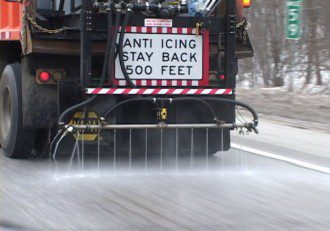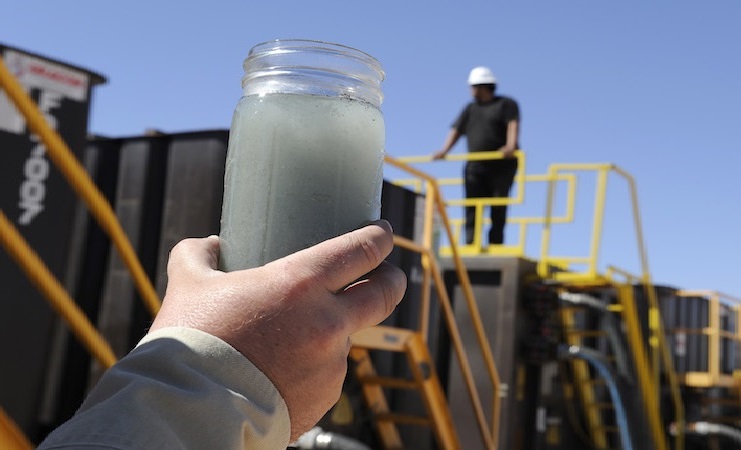Contributing Writer for Wake Up World
Just when we thought it couldn’t get much worse on the fracking front — polluted groundwater, poisoned environment, destroyed ecosystems — a dangerous new practice for ‘disposing’ of fracking wastewater has been put into action: spread it onto roadways for ice and dust management. Not only does the the flowback water from fracking contain a range of toxic compounds — including ammonium, iodide, heavy metals and bromide — it can also contain radioactive material.
For those unfamiliar with the process of fracking — known as hydraulic fracturing — a bit of history about the technique is helpful. Halliburton developed the process in 1949 and utilized the technology for decades with oil and gas wells to increase production, as they began to run dry. In conventional fracking, the well is stimulated by pumping-in water at high pressure. But hydraulic fracturing used for shale rock is a relatively new process and the one we hear most about today.
[pro_ad_display_adzone id=”110028″]
With this latest technology, the well is drilled vertically until it hits a shale layer, where drilling then turns horizontal. Once the horizontal well is drilled, millions of gallons of water and chemicals are pumped deep underground to destroy rocks and release the natural gas trapped within. Horizontal wells weren’t economically viable or widely used until the 1990’s.
The U.S. currently has 500,000 active gas wells, which require 72 trillion gallons of water and 360 billion gallons of chemicals to run. (source)
A Toxic Brew
“The technology is vastly outpacing what we know about the health effects” ~ James Burch, an associate professor in the University of South Carolina Department of Epidemiology and Biostatistics
Since the 1960’s, it’s been known that the Marcellus shale formation — a massive rock formation containing the largest source of natural gas in the United States, spanning New York, through Pennsylvania, Ohio and West Virginia — is radioactive. Recent measurements by New York State Department of Environmental Conservation (DEC) have shown that radium found in rock cuttings from drilling are over 200 times surface background concentration. Drilling for oil and natural gas brings this radioactivity to the surface in the form of solids (rock cuttings), liquids (drilling fluids, flowback water and brine), and gas (radon).
Says Marvin Resnikoff, Ph.D. in a report for the Delaware Riverkeeper Network in Bristol, Pennsylvania:
“This is not alchemy, where lead is magically turned into gold, or in the case of Marcellus shale, where radioactivity below ground, magically disappears when brought to the surface. Contaminated liquids, gases and solids will enter the accessible environment and be taken in by the public, increasing the likelihood of cancers. Radium-226 has a half-life of 1,600 years, so it will be present in the environment for thousands of years. It is also water soluble, meaning it easily travels with water via streams and rivers. One of its decay products, radon, is an inert gas, allowing it to travel with natural gas and enter homes through kitchen stoves, and from fugitive gas emissions throughout the natural gas distribution network.” (source)
Likewise, researchers at the University of Buffalo found the process of hydraulic fracturing causes uranium (a known carcinogen) naturally trapped within the Marcellus shale to be released. Moreover, when the millions of gallons of water from fracking return to the surface, there’s a good chance uranium contaminants will come back up with it — all the while generating toxic waste and polluting streams, as well as the ecosystem. Read more about the hazards of fracking here.
As if this weren’t bad enough, now the industry is selling fracking wastewater to municipalities who use the contaminated water on roadways.
A Brave New (Radioactive) World
Certain states in the U.S. ban the application of fracking wastewater on roadways — Texas is one. But since it’s becoming increasingly difficult to store, treat and dispose wastewater from the industry, many fracking operations are shipping their fluid to regions that do allow the spraying. Many times, the wastewater will be given away for free — a boon for municipalities that are looking to reduce costs associated with ice-slick or dusty roads.
Fracking wastewater (or brine) is laden with chloride (a salt) and does a great job melting ice since it’s up to 10 times saltier than typical road salt. Parts of Pennsylvania and New York allow spraying of the wastewater on roadways and both states’ environmental protection departments feel the practice is a “beneficial use” of industrial water — or, put another way, it “does not harm or threaten public health, safety, welfare or the environment.” (source)
To help protect the ecosystem, a number of regulations have been established. In Pennsylvania, brine cannot be spread within 150 feet of any body of water — such as streams, creeks and lakes. It also can’t be applied while it’s raining or if there is a chance of rain, in order to avoid runoff. Also, the slope of a road cannot be at an angle more than 10%.
However, considering oversight is sorely lacking within both departments — wastewater doesn’t need to be treated before applied onto roadways and New York isn’t sure exactly how much of the fracking fluid they use in any given year — it’s hard to believe either governmental agency has human — or nature’s — best interest at heart.
But this could change. Scott Perry, the deputy secretary for the Pennsylvania Department of Environmental Protection’s (DEP) Office of Oil and Gas Management, did come across a study showing a “potential for brine to migrate from the roadway and impact ground or surface water quality” — which gave him pause for thought.
“I think as a result of my reading that study, and the work we’ve done regarding [radioactivity], it seems to me that it’s really prudent for us to take another look at the use for road spreading,” said Perry. “I think we should go and take some other samples from the environment. It could result in no changes, that in fact the application rates in the guidelines prove themselves to be correct. And I think we should probably look at the effect of chlorides on water resources.”
Article sources:
- http://www.ncbi.nlm.nih.gov/pmc/articles/PMC4492256/
- http://www.newsweek.com/oil-and-gas-wastewater-used-de-ice-roads-new-york-and-pennsylvania-little-310684
- https://www.earthworksaction.org/library/detail/wasting_away_full_report#.Vo6BbTbGyAb
- http://www.sciencedaily.com/releases/2010/10/101025172926.htm
- http://www.nofrackingway.us/2013/12/04/how-to-get-radium-226-off-your-tires/
- http://www.riverkeeper.org/fracking/new-york’s-fracking-waste-problem/
- http://dnr.mo.gov/env/hwp/mrbca/ref/site-specific-background-concentrations-draft-050505.pdf [PDF]
Previous articles by Carolanne Wright:
- Clean and Green – Dutch Company Powers Gadgets and Street Lights with Living Plants
- Monsanto Charged with Crimes Against Nature and Humanity – Set to Stand Trial in 2016
- Considering the Flu Shot? Here are Five Reasons to Think Twice
- Dr Sebi: The Man Who Cures Aids, Cancer, Diabetes and More
- Plastic-Eating Mushroom Discovered in the Amazon Rainforest — A Solution for Our Trash Saturated World?
- Chronic Lyme Disease: A Modern Plague the Government Chooses to Ignore
- Big Pharma and Organized Crime — They are More Similar Than You May Think
- Over 100 Scientific Studies Agree: Cannabis Annihilates Cancer
- Emotional Energetic Healing: The Future of Medicine is Here
- Why Every Parent Should Consider Unschooling
- The Greenhouse of the Future: Grow Your Own Food Year-Round With This Revolutionary System
- First U.S. City Produces More Electricity Than It Uses — With 100% Renewable Technology
- Autistic Boy with Higher IQ Than Einstein Discovers Gift After Removal from State-Run Therapy
[pro_ad_display_adzone id=”110025″]
[pro_ad_display_adzone id=”110027″]








